engine TOYOTA MATRIX 2009 E140 / 2.G Owners Manual
[x] Cancel search | Manufacturer: TOYOTA, Model Year: 2009, Model line: MATRIX, Model: TOYOTA MATRIX 2009 E140 / 2.GPages: 440, PDF Size: 9.39 MB
Page 379 of 440
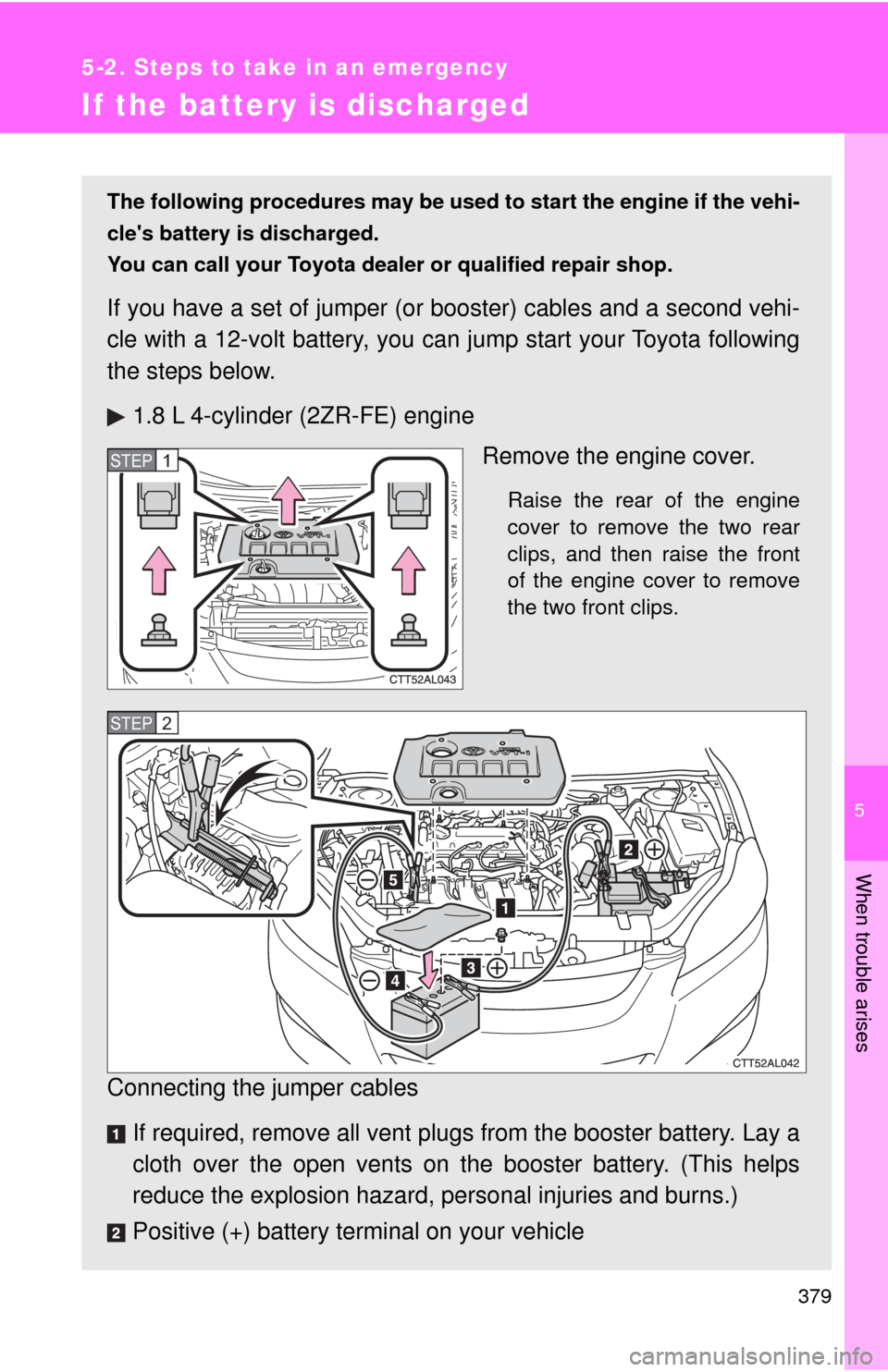
5
When trouble arises
379
5-2. Steps to take in an emergency
If the battery is discharged
The following procedures may be used to start the engine if the vehi-
cle's battery is discharged.
You can call your Toyota dealer or qualified repair shop.
If you have a set of jumper (or booster) cables and a second vehi-
cle with a 12-volt battery, you can jump start your Toyota following
the steps below.
1.8 L 4-cylinder (2ZR-FE) engine
Remove the engine cover.
Raise the rear of the engine
cover to remove the two rear
clips, and then raise the front
of the engine cover to remove
the two front clips.
Connecting the jumper cables
If required, remove all vent plugs from the booster battery. Lay a
cloth over the open vents on the booster battery. (This helps
reduce the explosion hazard, personal injuries and burns.)
Positive (+) battery terminal on your vehicle
STEP5STEP1
STEP2
Page 380 of 440

380 5-2. Steps to take in an emergency
Positive (+) battery terminal on the second vehicle
Negative (-) battery terminal on the second vehicle
Connect the jumper cable to ground on your vehicle as shown in
the illustration.
Start the engine of the second vehicle. Increase the engine
speed slightly and maintain at that level for approximately 5
minutes to recharge the battery of your vehicle.
Maintain the engine speed of the second vehicle, and turn
the engine switch to the “ON” position then start the vehi-
cle's engine.
Once the vehicle’s engine has started, remove the jumper
cables in the exact reverse order in which they were con-
nected.
Once the engine starts, have the vehicle checked at your Toyota
dealer as soon as possible.
STEP3
STEP4
STEP5
Page 381 of 440

5
When trouble arises
381 5-2. Steps to take in an emergency
2.4 L 4-cylinder (2AZ-FE) engine
Connecting the jumper cables
If required, remove all vent plugs from the booster battery. Lay a
cloth over the open vents on the booster battery. (This helps
reduce the explosion hazard, personal injuries and burns.)
Positive (+) battery terminal on your vehicle
Positive (+) battery terminal on the second vehicle
Negative (-) battery terminal on the second vehicle
Connect the jumper cable to ground on your vehicle as shown in
the illustration.
Start the engine of the second vehicle. Increase the engine
speed slightly and maintain at that level for approximately 5
minutes to recharge the battery of your vehicle.
Maintain the engine speed of the second vehicle, and turn
the engine switch to the “ON” position then start the vehi-
cle's engine.
STEP1
STEP2
STEP3
Page 382 of 440
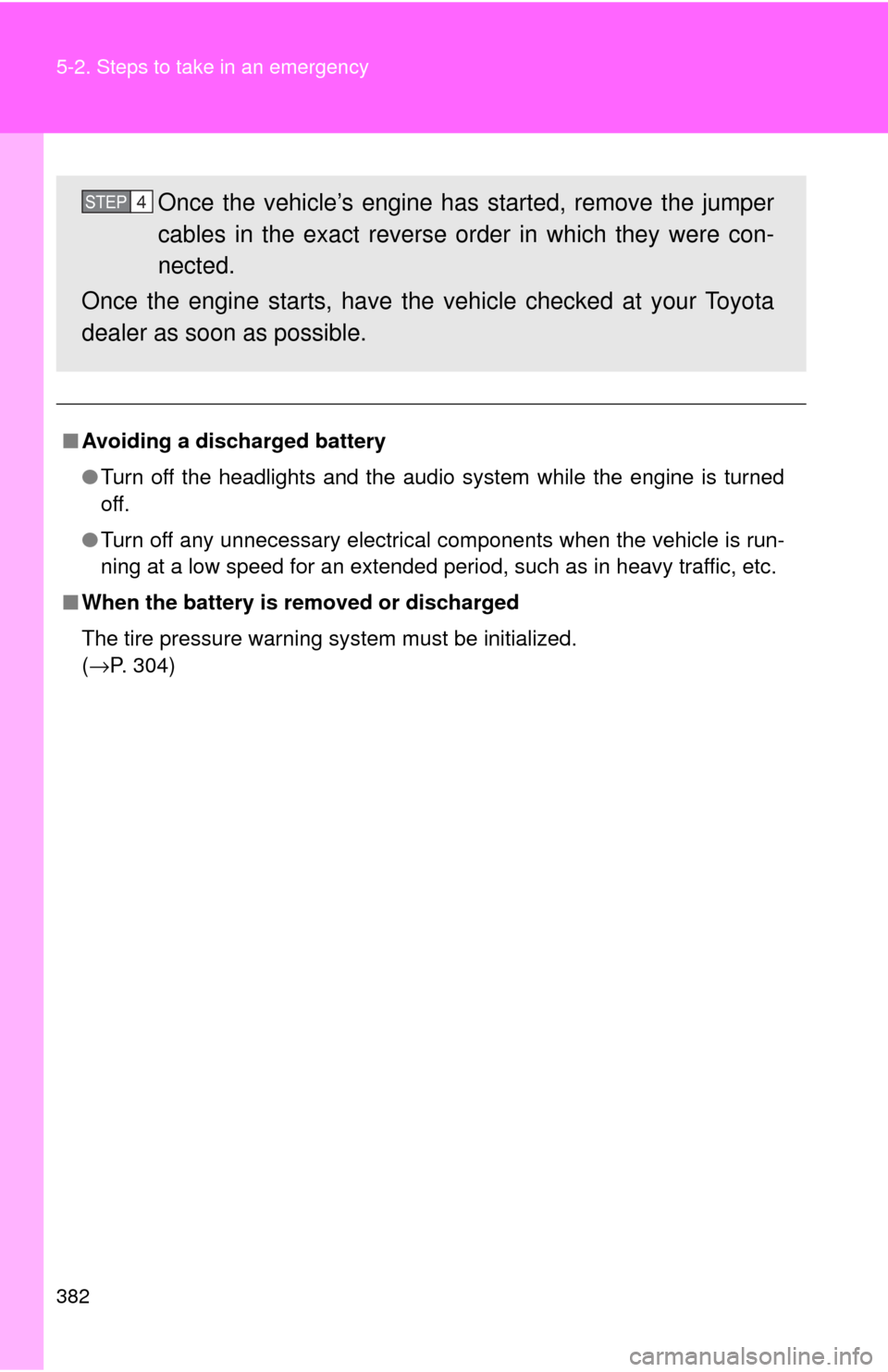
382 5-2. Steps to take in an emergency
■Avoiding a discharged battery
●Turn off the headlights and the audio system while the engine is turned
off.
●Turn off any unnecessary electrical components when the vehicle is run-
ning at a low speed for an extended period, such as in heavy traffic, etc.
■When the battery is removed or discharged
The tire pressure warning system must be initialized.
(→P. 304)
Once the vehicle’s engine has started, remove the jumper
cables in the exact reverse order in which they were con-
nected.
Once the engine starts, have the vehicle checked at your Toyota
dealer as soon as possible.STEP4
Page 384 of 440
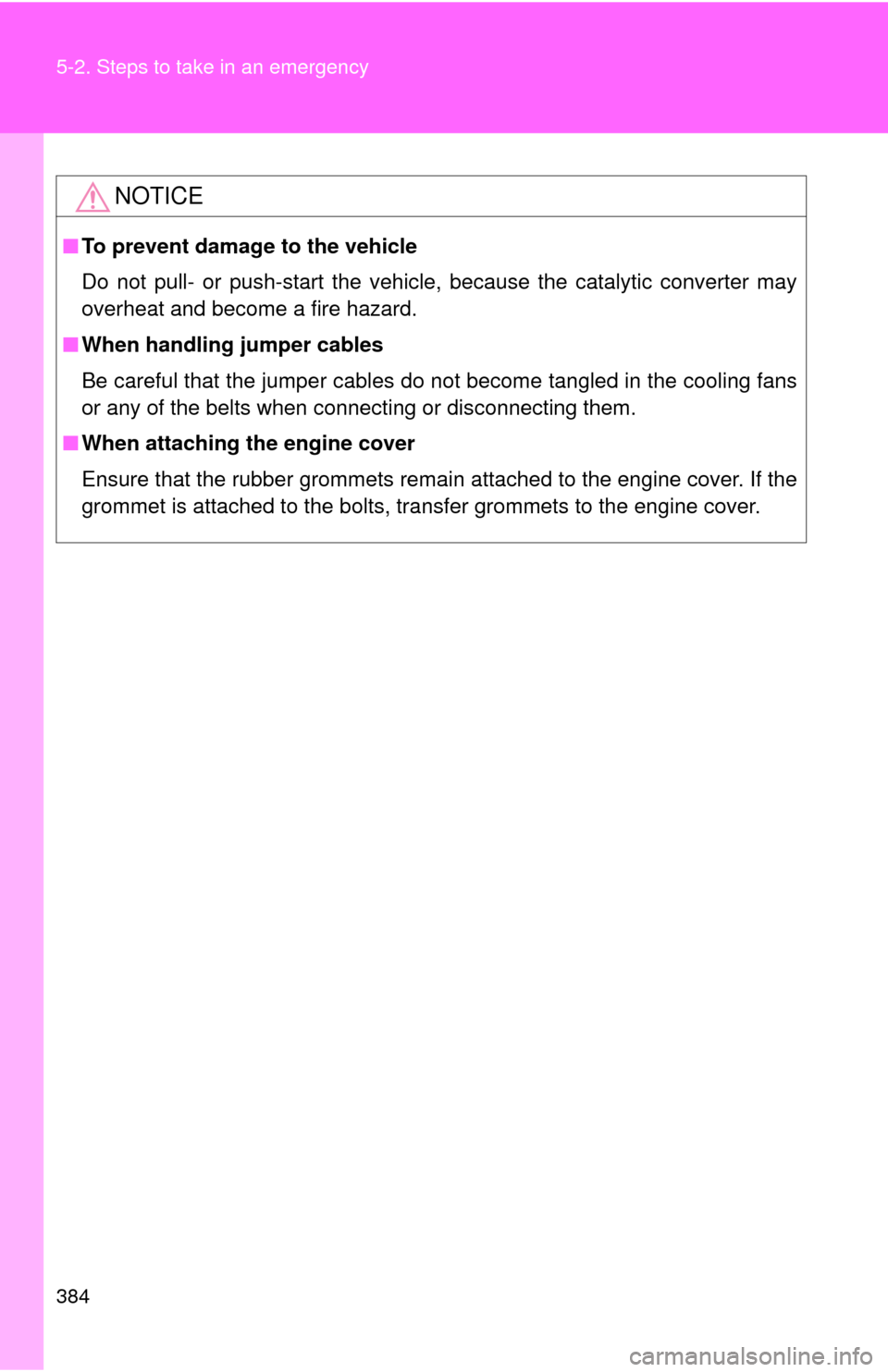
384 5-2. Steps to take in an emergency
NOTICE
■To prevent damage to the vehicle
Do not pull- or push-start the vehicle, because the catalytic converter may
overheat and become a fire hazard.
■When handling jumper cables
Be careful that the jumper cables do not become tangled in the cooling fans
or any of the belts when connecting or disconnecting them.
■When attaching the engine cover
Ensure that the rubber grommets remain attached to the engine cover. If the
grommet is attached to the bolts, transfer grommets to the engine cover.
Page 385 of 440

5
When trouble arises
385
5-2. Steps to take in an emergency
If your vehicle overheats
If your engine overheats:
Stop the vehicle in a safe place and turn off the air condi-
tioning system.
Check to see if steam is coming out from under the hood.
If you see steam:
Stop the engine. Wait until the steam subsides, and then
carefully lift the hood.
If you do not see steam:
Leave the engine running and carefully lift the hood.
Check to see if the cooling fans are operating.
If the fans are operating:
Wait until the temperature of the engine (shown on the
instrument cluster) begins to fall and then stop the
engine.
If the fans are not operating:
Stop the engine and call your Toyota dealer.
After the engine has cooled
down sufficiently, check the
engine coolant level and
inspect the radiator core (radi-
ator) for any leaks.STEP1
STEP2
STEP3
STEP5STEP4
Page 386 of 440
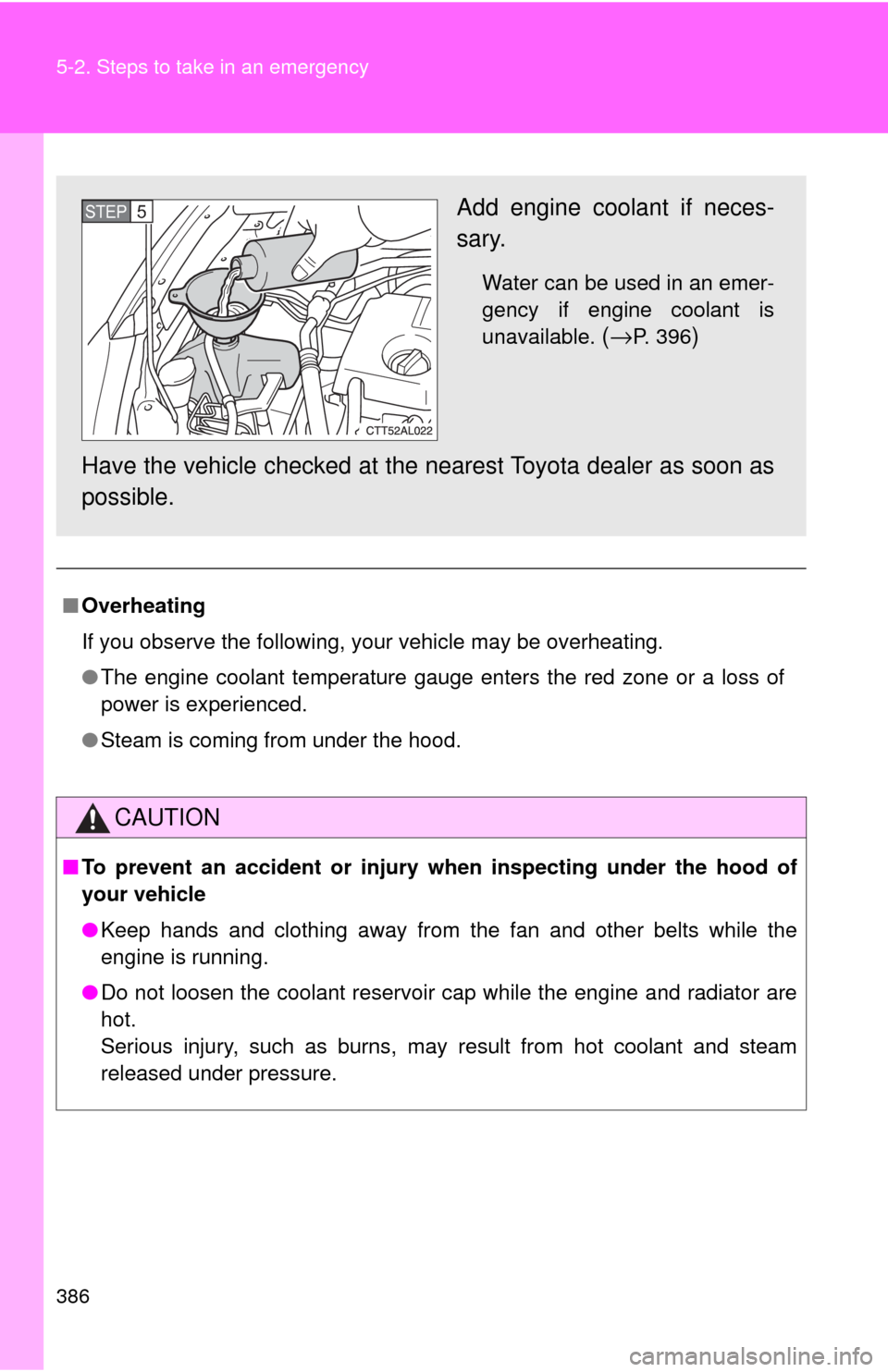
386 5-2. Steps to take in an emergency
■Overheating
If you observe the following, your vehicle may be overheating.
●The engine coolant temperature gauge enters the red zone or a loss of
power is experienced.
●Steam is coming from under the hood.
CAUTION
■To prevent an accident or injury when inspecting under the hood of
your vehicle
●Keep hands and clothing away from the fan and other belts while the
engine is running.
●Do not loosen the coolant reservoir cap while the engine and radiator are
hot.
Serious injury, such as burns, may result from hot coolant and steam
released under pressure.
Add engine coolant if neces-
sary.
Water can be used in an emer-
gency if engine coolant is
unavailable.
(→P. 396)
Have the vehicle checked at the nearest Toyota dealer as soon as
possible.
STEP5
Page 387 of 440
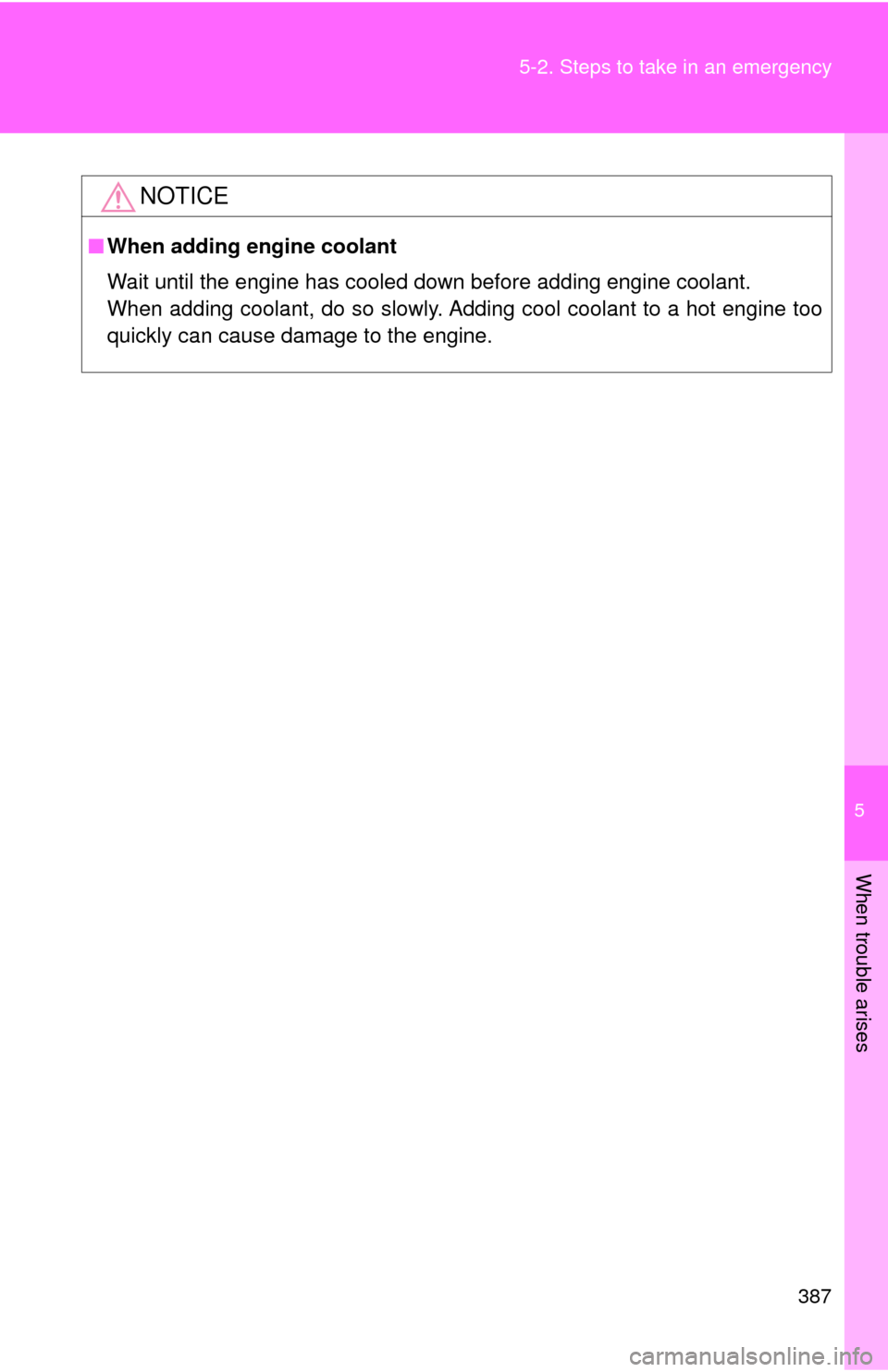
5
When trouble arises
387 5-2. Steps to take in an emergency
NOTICE
■When adding engine coolant
Wait until the engine has cooled down before adding engine coolant.
When adding coolant, do so slowly. Adding cool coolant to a hot engine too
quickly can cause damage to the engine.
Page 388 of 440
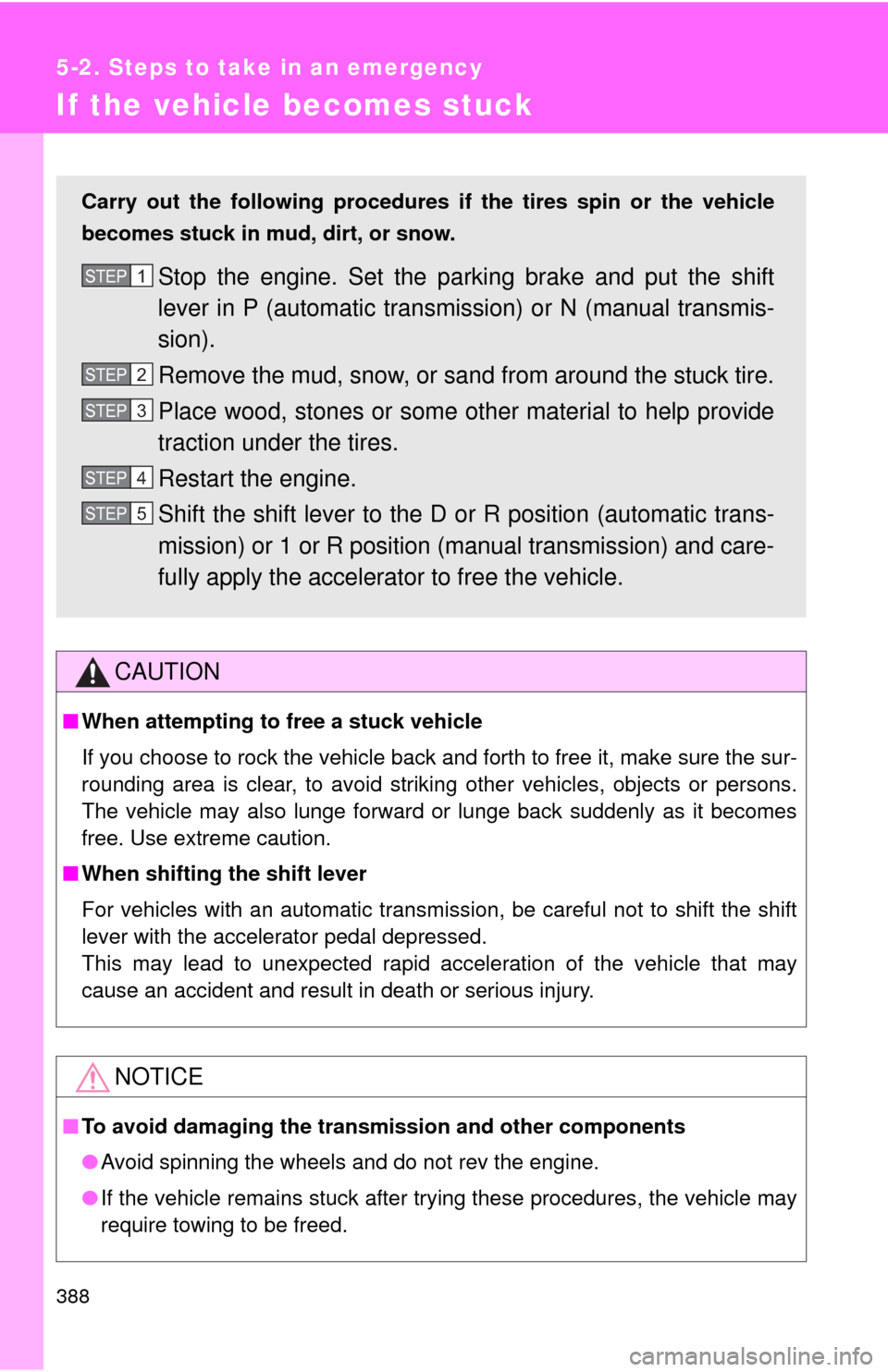
388
5-2. Steps to take in an emergency
If the vehicle becomes stuck
CAUTION
■When attempting to free a stuck vehicle
If you choose to rock the vehicle back and forth to free it, make sure the sur-
rounding area is clear, to avoid striking other vehicles, objects or persons.
The vehicle may also lunge forward or lunge back suddenly as it becomes
free. Use extreme caution.
■When shifting the shift lever
For vehicles with an automatic transmission, be careful not to shift the shift
lever with the accelerator pedal depressed.
This may lead to unexpected rapid acceleration of the vehicle that may
cause an accident and result in death or serious injury.
NOTICE
■To avoid damaging the transmission and other components
●Avoid spinning the wheels and do not rev the engine.
●If the vehicle remains stuck after trying these procedures, the vehicle may
require towing to be freed.
Carry out the following procedures if the tires spin or the vehicle
becomes stuck in mud, dirt, or snow.
Stop the engine. Set the parking brake and put the shift
lever in P (automatic transmission) or N (manual transmis-
sion).
Remove the mud, snow, or sand from around the stuck tire.
Place wood, stones or some other material to help provide
traction under the tires.
Restart the engine.
Shift the shift lever to the D or R position (automatic trans-
mission) or 1 or R position (manual transmission) and care-
fully apply the accelerator to free the vehicle.STEP1
STEP2
STEP3
STEP4
STEP5
Page 390 of 440
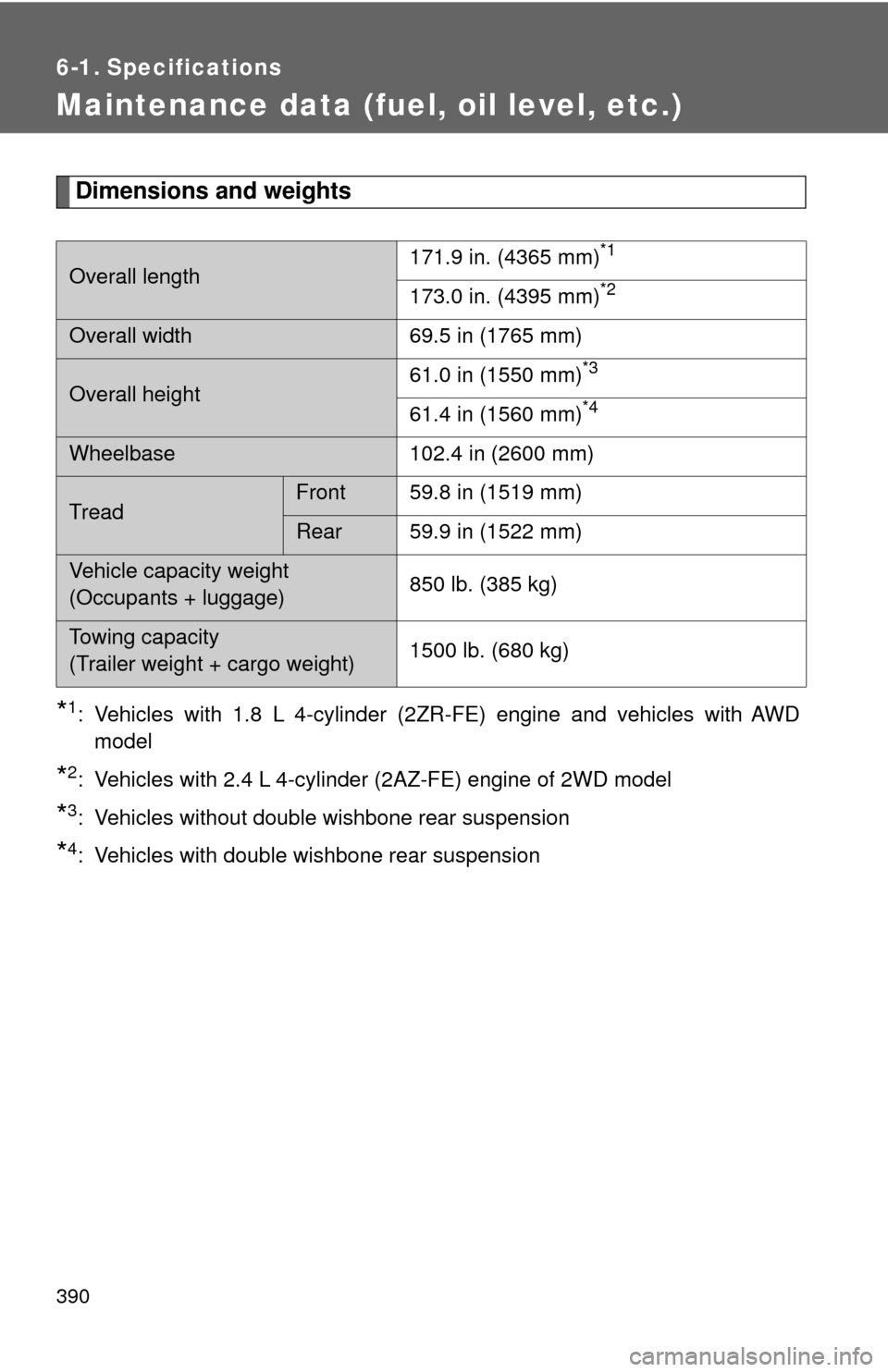
390
6-1. Specifications
Maintenance data (fuel, oil level, etc.)
Dimensions and weights
*1: Vehicles with 1.8 L 4-cylinder (2ZR-FE) engine and vehicles with AWD
model
*2: Vehicles with 2.4 L 4-cylinder (2AZ-FE) engine of 2WD model
*3: Vehicles without double wishbone rear suspension
*4: Vehicles with double wishbone rear suspension
Overall length171.9 in. (4365 mm)
*1
173.0 in. (4395 mm)*2
Overall width 69.5 in (1765 mm)
Overall height61.0 in (1550 mm)
*3
61.4 in (1560 mm)*4
Wheelbase 102.4 in (2600 mm)
TreadFront 59.8 in (1519 mm)
Rear 59.9 in (1522 mm)
Vehicle capacity weight
(Occupants + luggage)850 lb. (385 kg)
Towing capacity
(Trailer weight + cargo weight)1500 lb. (680 kg)